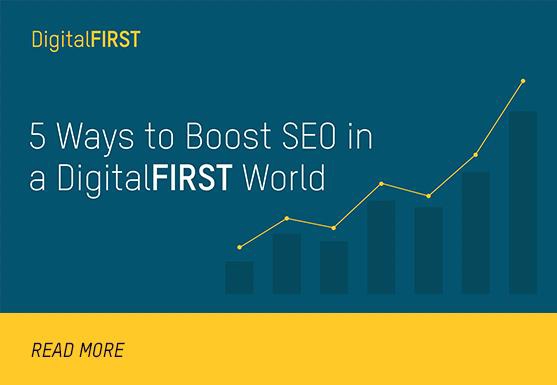5 Ways to Boost SEO in a DigitalFIRST World

Not that long ago, organic search strategies mostly involved shoehorning top performing keywords into existing content. Title tags might be created and linking outreach conducted, but that would usually cover it.
Oh how times have changed.
Thanks to advances in technology, brands now have the ability to target and interact with their customers in ways that seemed unimaginable just a few years ago, particularly when it comes to search. And while keywords still matter, today’s successful brands are thinking bigger – by thinking digital first.
Digital-first thinking places digital habits, expectations, and the customer journey at the forefront. Today, non-linear journeys are the norm and marketers must assume that consumers are discovering their brands primarily through digital means. By thinking digital first, brands stand a much higher chance of truly connecting with modern audiences - and this holds especially true for search.
So how should your brand’s SEO strategy evolve to reach today’s digital first customer?
1. Really, Really, Really Know Your Customer
To be successful in the digital-first search environment, it’s all about understanding your customer, their needs and the problems you can help them solve. By really knowing your customer, you can develop unique and creative messaging that emotionally resonates with them – not just a search algorithm. Your messaging can then be used in paid and organic search as well as social, video and traditional channels. In the past, identifying high performing keywords and incorporating them into your search strategy was often enough to move the needle. Not anymore. Today, Google and other search engines reward unique and helpful messaging that elicits audience interaction. Which leads us to #2…
2. Think Beyond The Click
It used to be all about getting the click – now search engines are more interested in how your visitors are interacting with your content once they arrive. Are your customers finding the answers they’re looking for? Are they clicking around your site? Are they spending sufficient time in various sections? Or are they clicking once and quickly leaving? There are a myriad of tools to help answer these questions, as today it’s all about satisfying user intent, which is directly tied into #1: Knowing Your Customer. The better job you do meeting your customers’ needs – and keeping their attention – the more you’ll be rewarded in search results.
3. Create Original Content
From images to video to short and long-form copy, the more original you can make your content the better. If you do curate some content, make sure to give proper attribution – and also add a few thoughts to make it your own. It’s important for your journalistic voice to shine through. Also keep in mind that the value of short articles is in flux from an SEO perspective. These days longer articles (between 1,200 to 1,500 words) tend to garner more authority and traffic. They also get shared and linked to more often. That said, most of your customers will probably be accessing your content from a mobile device, so break up long paragraphs, use bullet points where possible and add photos, captions or call-outs to improve the visual flow.
4. Optimize For Mobile
Americans now spend more time each day on mobile devices than watching TV - so yeah, mobile matters. And with more searches being performed on mobile than desktop and more people accessing websites and reading emails on mobile, the shift to consume content via mobile is only expected to grow. Google recognized this fact, which is why they now incorporate “mobile friendliness” as a ranking factor. In essence, the search giant is rewarding you for providing your visitors with an experience they already want – so make sure to give it to them. Not only will you make your customers happier, you’ll boost your authority as well.
5. Remember Voice Search
When you’re developing written and visual content, keep in mind that 55% of teens and 41% of adults use voice search on a daily basis. Whether it’s Siri, Google Voice Search, Google Home or Alexa (Amazon), voice and sound activated virtual assistants are moving from novelty to necessity. So make sure to keep your content conversational in tone by using natural sentence structures and phrases. Why? As the technology advances, voice search returns will increasingly align with the ways that users speak – and not solely on specific keywords. Various techniques can also be applied to help your brand benefit from voice search including Schema markup. This is simply an add-on to the HTML web coding that provides additional information for the search engines to find such as product reviews, hours of operation and even payment methods accepted.
Ready to boost your SEO in a Digital-First world? Give Rhythm a shout.